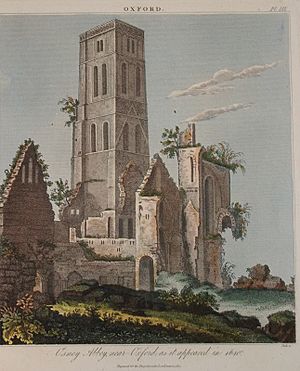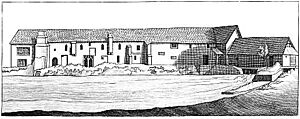Osney Abbey facts for kids
Quick facts for kids Osney Cathedral |
|
|---|---|

Engraving of Osney Abbey in 1640
|
|
| History | |
| Founded | x1541-1545 |
| Dedication | St George |
| Associated people | Robert D'Oyly |
| Administration | |
| Diocese | Diocese of Oxford |
Osney Abbey, also known as Oseney Abbey, was once a very important religious house in Oxfordshire, England. It was home to Augustinian canons, who were a type of priest living in a community. The abbey was located in Osney, a part of Oxford. You can find its former site south of the modern Botley Road, near Mill Street and Osney Cemetery, right by the railway line south of Oxford station.
Osney Abbey started as a smaller religious house called a priory in 1129. It grew into a larger abbey around 1154. In 1539, like many other religious houses in England, it was closed down. However, for a short time, it became a cathedral. The last abbot, Robert King, even became the first Bishop of Oxford. But by 1545, the cathedral moved to Christ Church, and Osney Abbey slowly turned into ruins. It was one of four famous monasteries in medieval Oxford, alongside St Frideswide's Priory, Rewley Abbey, and Godstow Abbey.
The Abbey's Story
Osney Abbey was founded by Robert D'Oyly the younger, who was a Norman governor of Oxford. His wife, Edith Forne, encouraged him to build it. She wanted to do good deeds and help others. A story says that magpies chattering inspired her, and a chaplain told her it meant souls needed a monastery to help them. This led to the abbey's creation.
Edith Forne was buried at Osney Abbey. John Leland, a historian, saw her tomb before the abbey was closed. He described an image of Edith made of stone, holding a heart, near the main altar. The legendary magpie dream was even painted near her tomb.
Osney was one of the most important Augustinian houses in medieval England. It helped establish other religious communities. For example, in 1177, Osney provided six canons for the re-founding of the Church of the Holy Cross in Waltham. When Waltham became an abbey in 1184, its first abbot came from Osney. In 1199, the church of St George in Oxford Castle was moved and joined with Osney Abbey.

A major event happened at the abbey in April 1222. A big church meeting was held there to apply new rules from the Fourth Council of the Lateran. Later, in July 1237, a special church official called a papal legate, Otto Cardinal Candidus, visited Osney. A fight broke out between some students from the university and the cardinal's staff. The cardinal's cook was killed. Cardinal Otto himself had to hide in the abbey tower for safety. After he came out unharmed, he punished the city by placing it under an interdict, which meant many church services were temporarily stopped.
It's believed that the canons of Osney Abbey changed the course of the River Thames near the abbey. They did this to power their mill, which would have been important for grinding grain.
After the abbey was closed in 1539, it became the home of the new Bishops of Oxford from 1542 to 1544. Then, the bishop's seat moved to Christ Church. Osney Abbey is often called the greatest building Oxford has lost. Great Tom, a famous bell known as the 'loudest thing in Oxford', now hangs in Tom Tower at Christ Church. This bell was originally from Osney Abbey's tower. Many of the abbey's valuable items and buildings were also moved to Christ Church. The remaining parts of the abbey were used as building materials for the city and by King Charles I during the Civil War. Drawings of the ruins were made by John Aubrey in 1640, and later by Thomas Hearne in 1720, showing how much of the abbey had disappeared.
Important Burials
Some notable people were buried at Osney Abbey:
- Ela Longespée
- Edith Forne
Osney Today
Today, almost all the original abbey buildings are gone. Only a small structure made of rubble and timber, possibly from the 15th century, remains. This remnant was officially protected as a Grade II listed building in 1954.
On the same site, you can find the old Osney Mill, which is no longer used, and Osney Lock. To the west is Osney Cemetery, and to the south is Osney Mill Marina, located on a long island that was originally created for the mill. To the north are the busy Botley Road, a main road leading out of Oxford, and Oxford railway station.

